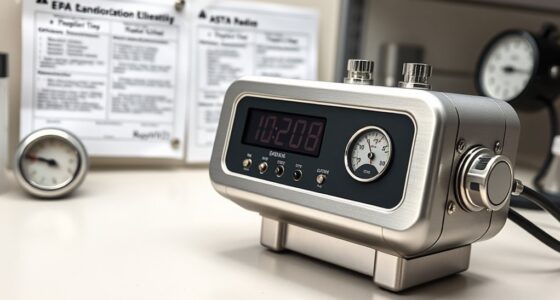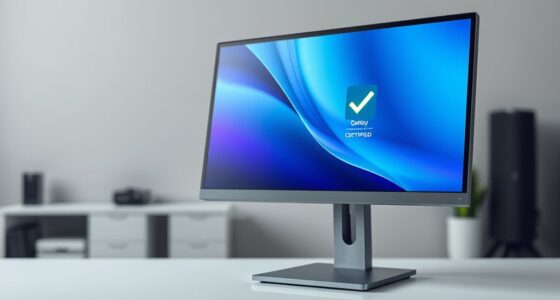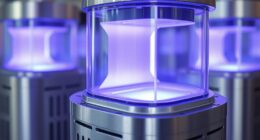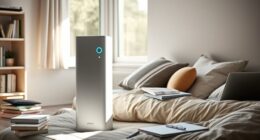Understanding ISO 16890 helps you compare air filters based on their ability to capture airborne particles like PM1, PM2.5, and PM10. This standard provides a clear classification system, making it easier to choose filters that suit your indoor air quality needs. It also guarantees filters meet consistent performance criteria, giving you confidence in their effectiveness. Continuing with this knowledge will reveal how this standard impacts your indoor environment and HVAC system choices.
Key Takeaways
- ISO 16890 standardizes air filter classifications based on their efficiency at capturing PM1, PM2.5, and PM10 particles.
- It simplifies filter selection by providing consistent performance data across different manufacturers.
- The standard involves rigorous testing with specific particle sizes to determine filter efficiency and classification.
- Higher classification filters improve indoor air quality but may increase system pressure drops.
- Understanding ISO 16890 helps optimize HVAC performance and ensures effective removal of airborne pollutants.

The ISO 16890 Air Filter Standard is a essential guideline that helps you understand and compare the efficiency of different air filters. It provides a clear framework for evaluating how well filters remove airborne particles, which directly impacts indoor air quality. When it comes to selecting the right filter for your space, understanding this standard simplifies your decision-making process. It’s designed to give you confidence that the filter you choose will perform as expected, especially when considering air filter testing methods used to determine their efficiency.
This standard classifies filters based on their ability to capture particles of different sizes, primarily focusing on PM1, PM2.5, and PM10 categories. These classifications are crucial because they help you identify which filters are effective against the specific pollutants present in your indoor environment. For example, if you’re concerned about fine particles like smoke or allergens, you’ll want a filter rated to capture smaller particles in the PM2.5 range. The classification system also ensures consistency across manufacturers, so you can compare filters with ease, knowing they meet the same rigorous criteria.
Indoor air quality is at the heart of what ISO 16890 aims to improve. Better filtration means cleaner air, which can substantially reduce health risks associated with airborne pollutants. When selecting an air filter, you should consider its efficiency rating within the ISO 16890 framework. Filters with higher classifications generally remove more pollutants, but they also tend to have higher pressure drops, which can affect your HVAC system’s efficiency. Striking the right balance between filtration performance and system compatibility is essential for maintaining ideal indoor air quality without overburdening your system.
Higher filter classifications improve air quality but may increase system pressure drops, so balance performance with HVAC efficiency.
Air filter testing under ISO 16890 is thorough and standardized, meaning every filter’s efficiency is measured under consistent conditions. This testing involves challenging filters with specific particle sizes and measuring how many particles pass through. The results are then used to assign the filter a classification, such as ePM1, ePM2.5, or ePM10, indicating its effectiveness against different particle sizes. This uniform testing process ensures that when you compare filters, you’re evaluating them based on reliable, comparable data. It helps you make informed choices that enhance indoor air quality, protect your health, and improve your HVAC system’s performance. Additionally, understanding filter classification can help you select the most appropriate air filtration solution for your specific needs.
Frequently Asked Questions
How Does ISO 16890 Compare to ASHRAE Standards?
You’ll find that ISO 16890 and ASHRAE standards differ mainly in comparison standards and testing methods. ISO 16890 classifies filters based on their particle removal efficiency across three groups, using standardized testing methods. In contrast, ASHRAE focuses on performance criteria like MERV ratings for specific applications. Both aim to guarantee air quality, but ISO offers a more exhaustive, globally recognized classification system.
Can ISO 16890 Filters Be Used in Residential HVAC Systems?
Yes, ISO 16890 filters can be used in residential HVAC systems. They offer reliable, rigorous filtering, ensuring residential compatibility while maintaining filter efficiency. With their standardized classification, you can confidently select filters that effectively trap pollutants, providing cleaner indoor air. These filters are designed to meet the needs of homes, delivering ideal performance and improved air quality without compromising system operation.
What Testing Methods Are Used to Classify Filters Under ISO 16890?
You use testing protocols involving particle measurement to classify filters under ISO 16890. These protocols measure how effectively filters capture particles of different sizes, typically ranging from 0.3 to 10 micrometers. You test the filters in controlled laboratory settings, evaluating their efficiency across various particle sizes. This process helps determine their classification, such as ePM1, ePM2.5, or ePM10, indicating their filtration performance for different airborne particles.
Are ISO 16890 Classifications Applicable Worldwide or Region-Specific?
ISO 16890 classifications have global applicability, meaning you can rely on them worldwide for consistent air filter standards. They’re designed to complement and sometimes supersede regional standards, ensuring compatibility across markets. If you’re operating internationally, adopting ISO 16890 helps you meet global air quality requirements while aligning with regional standards, making your filtration systems more versatile and compliant across different countries and industries.
How Often Should ISO 16890 Filters Be Replaced for Optimal Performance?
Sure, because waiting until your filters are completely clogged is the best plan, right? In reality, you should replace ISO 16890 filters every 3 to 6 months for ideal filter lifespan. Regular filter replacement frequency ensures your system runs smoothly and efficiently, preventing air quality issues. Don’t risk the air you breathe—stay ahead of the game by monitoring and replacing filters on a schedule that maximizes their performance.
Conclusion
Understanding ISO 16890 is like opening a secret code to cleaner air. It empowers you to make informed choices, ensuring your environment stays fresh and healthy. By aligning your filters with this standard, you’re not just filtering air—you’re clearing the path for better health and peace of mind. Think of it as giving your space a gust of fresh air every day, where quality and clarity come together in perfect harmony.










